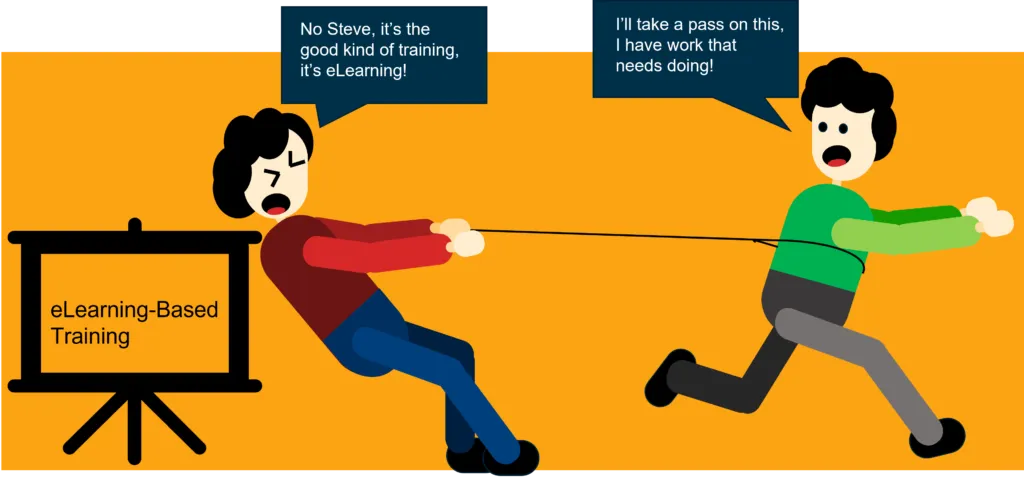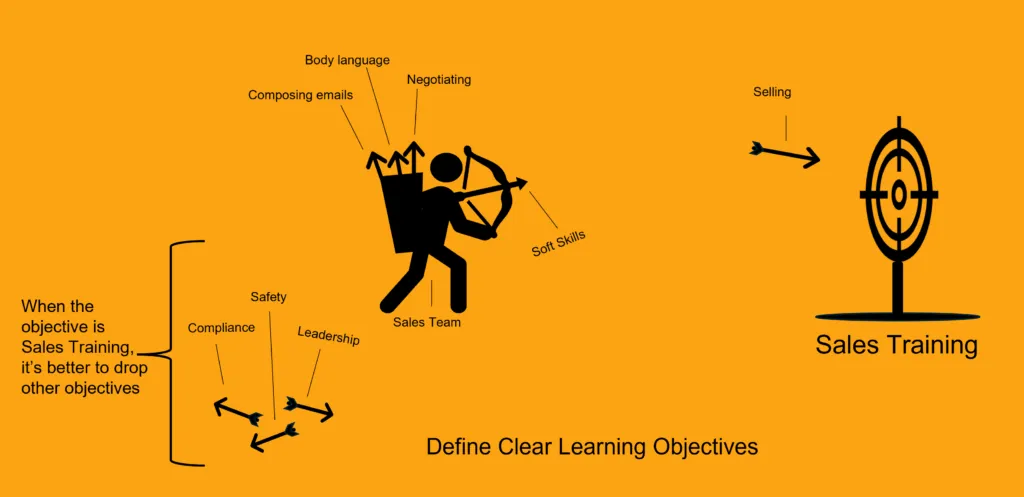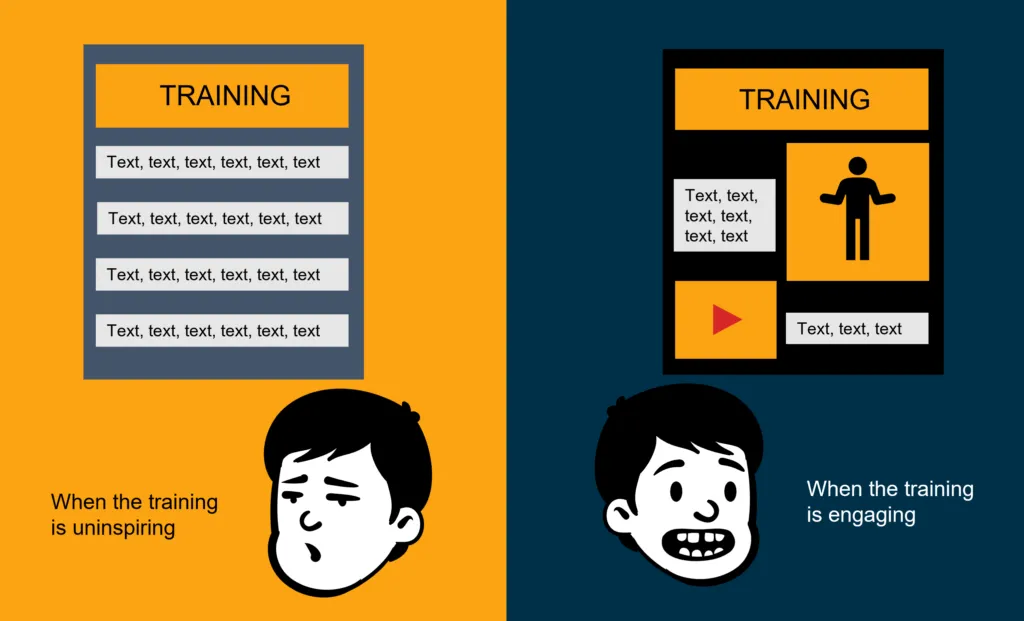Engaged learners are motivated, inspired, and willing to invest their personal (free) time in building themselves. Building and deploying training that is engaging is a challenge. And how you motivate employees to accept eLearning in the first place is a bonus problem that corporate L&D are most often trying to answer. Whether the challenge is to just get learners to enroll or keep them hooked till they finish their training, it’s all about understanding if your learners are motivated enough to accept training.
While companies have options like readymade or custom eLearning courses to choose from, the engagement and subsequent motivation problems remain constant for both.
So how do you keep learners engaged and what kind of engagement motivates employees to accept eLearning at your workplace?
6 Ways to Motivate Employees to Accept eLearning

Define Clear Learning Objectives
Motivation arises from the drive or an urge to meet your goal or a target. When learners are presented with a clear set of objectives that need to be achieved, it gives them a direction to channel their energies towards. Objectives work as measurable benchmarks against which learners can compare their progress. ‘How close am I to completion?’ ‘How good are my skills now?’ are some questions that a learner can answer with extreme clarity only after a clear set of objectives are defined for them. The ability to measure one’s success is the first spark that ignites true motivation.
When learners can see the ‘end goal’ in sight, it makes their journey simpler, it gives them direction, and once armed with the knowledge of where they need to be, a learner is more likely to set out with greater motivation to achieve their goals. To motivate employees, it’s crucial to show them ‘where they are now’ and ‘where they will be’ at the end of the journey, and when the destination holds something of benefit to the employees, they’ll find the motivation needed to achieve it.

How to Set Learning Objectives
To set the learning objectives, first, understand the learner’s macro and micro development needs. Macro needs are the major skill gaps that an employee may have or some language barriers they face which could make training difficult for them. Also determine if a learner is being considered for a new role? Or do they have to learn a new technology-based skill? All of these questions should help you determine your learner’s macro needs and it’s important to know these.
Micro needs on the other hand talk about the type of learning that learners prefer or the mode or device on which learning is accepted, and other similar questions which are smaller in nature and those which can easily be addressed to enhance a learner’s training experience and needs.
Surveys are a great way to understand your learners’ competence levels, including what worked and what did not. Asking a test group of learners about their wants and preferences is also a good way to assess learner needs. Be clear about determining what your learners expect from the training and then be sure to include ‘their wants’ in the training if possible.
Remember, each learner will have a unique set of needs, but trying to fulfill each need may be a little complicated. So your goal should be to fulfill each need to whatever extent possible without going overboard or diverging from the primary goal of training every learner. Your goal is to motivate ‘all employees’ to except eLearning and not just ‘a employee.’
Include Creative Course Content
Boredom plays a significant role in disengaging learners, forcing many learners to discontinue their training. Content that is intuitive, thought provoking, contextual, and creative can do a good job of reengaging such learners if the problem of boring training is identified and caught on time. Motivating employees to complete training can also be considered a very fine art. The motivation in this case is the same type as one would experience when reading a compelling book or novel.
Yes, the training content may be difficult, complex, or boring but important, but if you can use intelligent design and innovative eLearning solutions to balance the training, you’ll be able to motivate employees just enough to complete the training.

Adding elements of gamification and other modern technologies like AR and VR can motivate employees to accept eLearning by increasing the fun metrics of your training which will eventually increase the engagement level of the course content as well. Look for innovative eLearning solutions that can both keep learners motivated while helping you achieve the learning objectives.
Another method of engaging learners is by making the training user-friendly, self-explanatory, and easy to connect with, even for people with limited tech skills. It’s also worth experimenting with a wide range of training formats like videos, images, texts, and combinations of each, as a healthy mix of training formats will make the training more dynamic and engaging.
Use Updated Strategies for Learner-Engagement
Training employees in the current day and time is all about convenience. More often than not, employed learners have very little time on hand to brush-up on concepts. Think of the retail sector where employees are expected to look after customers all the time. Some retail employees work long shifts, while many regularly work overtime to fill in for absent colleagues.
You cannot expect some learners to go out of their way to learn, when work and life is already demanding too much from them. In such cases, you may have to consider giving your learners absolute freedom over where, when, and how they choose to learn.

Expecting such employees to go out of their way to learn and build their skills for your company’s benefits may be asking a little too much.
This is where convenience becomes the key to engaging learners. Setting up learning stations around the floor space or in break rooms will give your employees access to training while on the job. But even then why would they still care to spend any time learning? The key here is to provide them with information that is central helping them do their jobs better. This is what motivates employees to accept eLearning based training.
Giving your training context makes it valuable. Follow it up with training that is easy to consume and you’re one step closer to engaging learners. For instance, the course could offer learning materials by breaking up the content into small and easily digestible chunks such as infographics, interactive videos, quizzes, templates, checklists, etc.
Reward the Learners
Rewarding learners for their progress is another tried and tested method to motivate employees to accept eLearning at your workplace. Acknowledging learner efforts and motivating them to perform better definitely boosts the training activity because somewhere, people want to be appreciated for taking the time to learn. Definitely, rewards can help, but before you role out rewards, look again if those rewards are really what your learners want.
There are multiple tactics that can be employed. For instance, a simple leaderboard which proudly displays the names of top performers plays a very psychological role in motivating learners to build themselves in order to appear among the best and on top of the board. Certifying employees for learning and successfully completing a course is beneficial, especially in the day of digital media where everybody can see your certificates and proud employees can flaunt it.
Alternatively, you can also give them real-world rewards such as a promotion, performance bonus, paid time-offs, discount coupons, membership cards, etc. You get the drift!


Create Open Communication Channels
Throughout the learning journey, one key aspect to observe is keeping your communication channels open. Communication should be the priority of your eLearning-based training initiative. Start by collecting the macro and micro needs of your learners and end by considering your learners’ feedback with an open mind. Try acknowledging and responding to every feedback at the earliest.
Your objective is to create an environment or a community around learning and development. Building and managing open forums for casual discussions or promoting peer-to-peer knowledge transfer and other similar activities is how you can build this community. A community feeling definitely increases the engagement metric by including the element of socializing and works well to motivate employees to accept eLearning based training.
Motivate Employees to Accept eLearning is a Continuous Process
All said and done, remember that to motivate learners to accept eLearning is a continuous process. Make a point to motivate learners all the time, throughout the course. The aim is to hit the sweet spot where learners are engaged and motivated at the same time. That’s when the learners will also believe that learning is a continuous process -irrespective of the work hours.

Here are some quick pointers to make your eLearning more interesting:
- Keep the content conversational.
- Insert conceptual graphics, videos, quizzes, assessments, games, etc.
- Design bite-sized courses.
- Validate learning with questions along the way.
- Appreciate your learner’s efforts as reinforcements to boost their engagement.
We believe in building engaging and learner-friendly content by stepping in the learner’s shoes. If you are looking to create meaningful courses with consumable chunks of information to hold the interest and motivate employees to learn more, your quest is over! Talk to our team of wizards now! And remember, motivate employees to accept eLearning based training and in return your employees will thank you!






